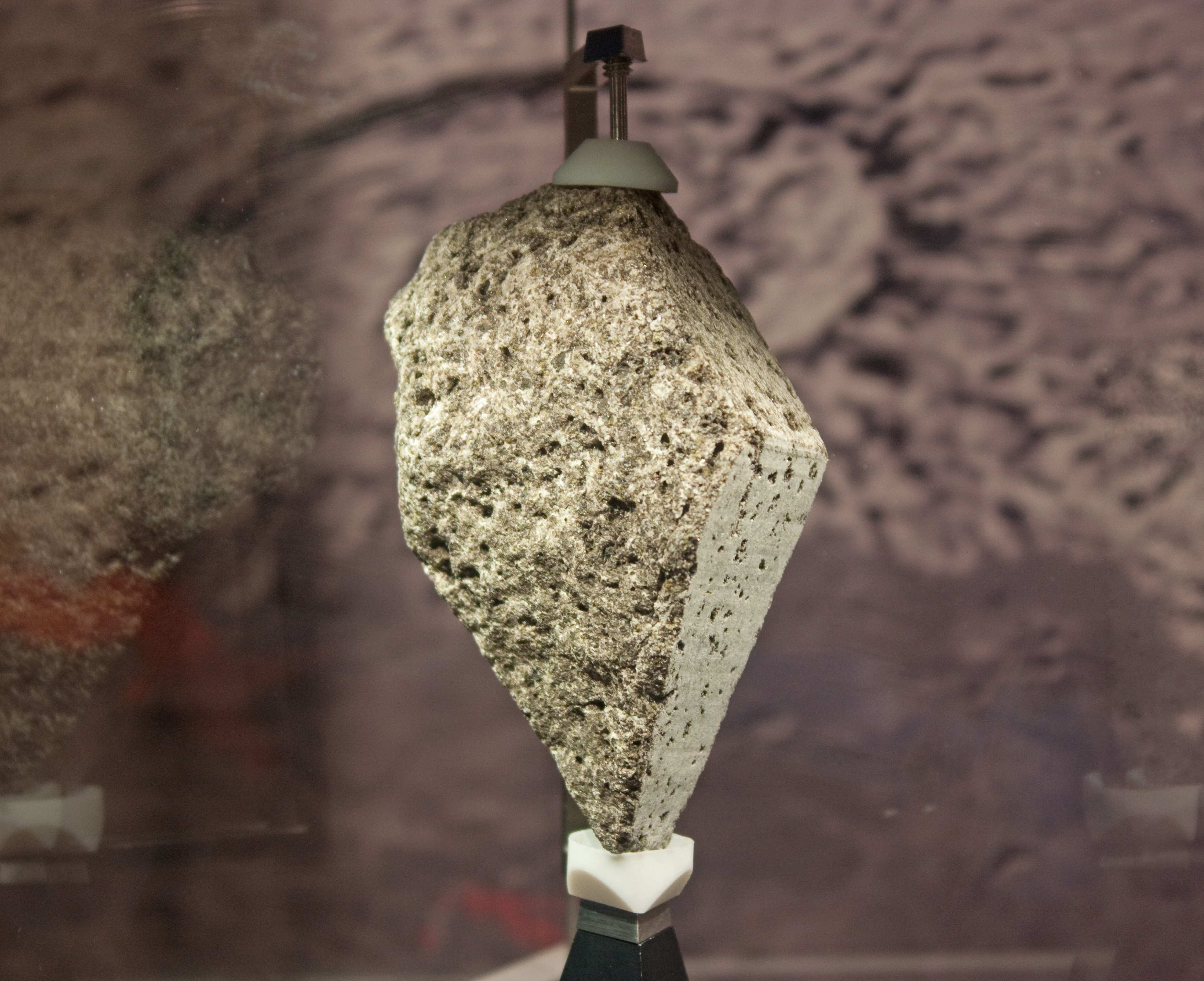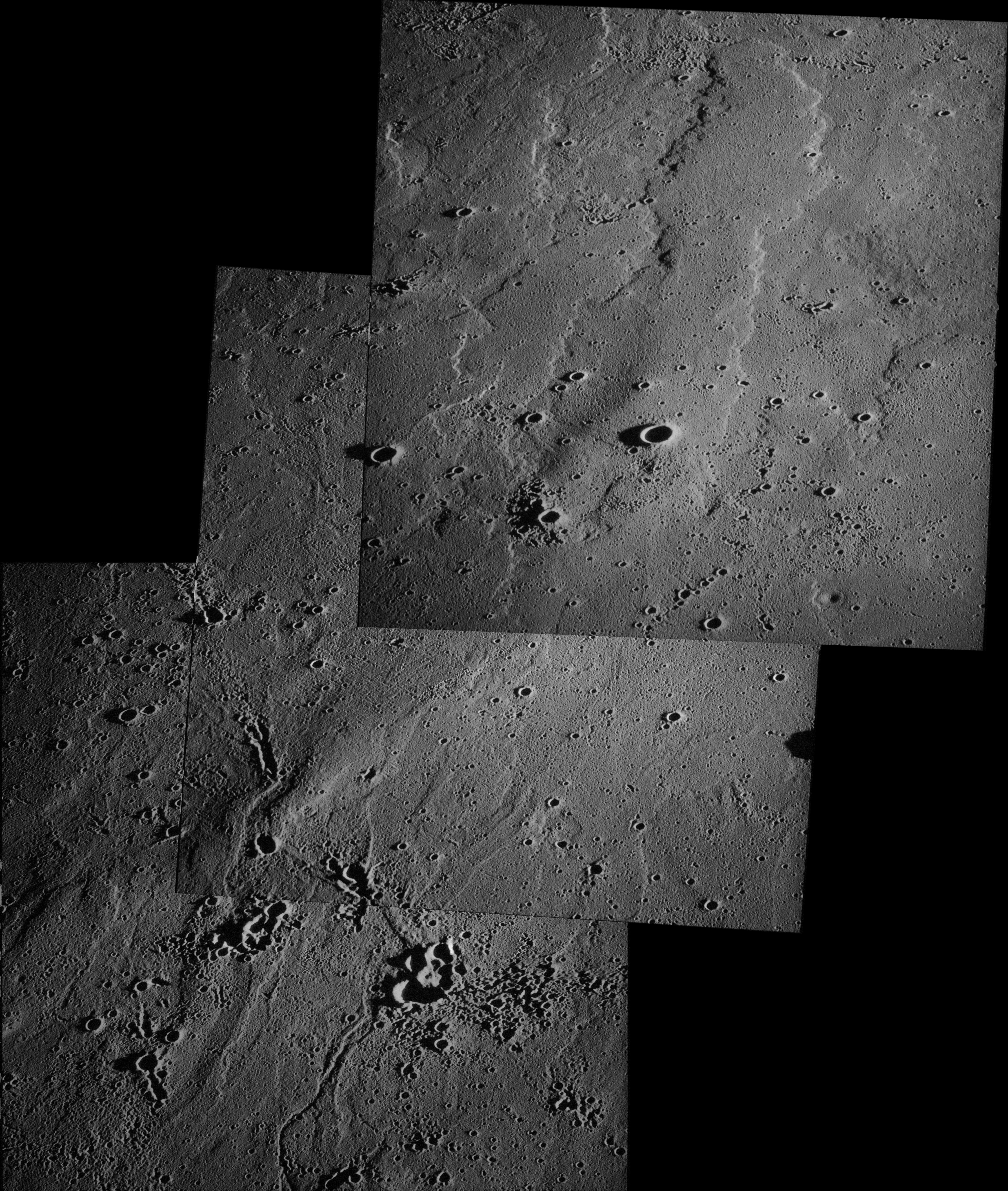|
Apollo 17
Apollo 17 (December 7–19, 1972) was the eleventh and final mission of NASA's Apollo program, the sixth and most recent time humans have set foot on the Moon. Commander Gene Cernan and Lunar Module Pilot Harrison Schmitt walked on the Moon, while Command Module Pilot Ronald Evans (astronaut), Ronald Evans orbited above. Schmitt was the only professional geologist to land on the Moon; he was selected in place of Joe Engle, as NASA had been under pressure to send a scientist to the Moon. The mission's heavy emphasis on science meant the inclusion of a number of new experiments, including a Fe, Fi, Fo, Fum, and Phooey, biological experiment containing five mice that was carried in the command module. Mission planners had two primary goals in deciding on the landing site: to sample Lunar highlands, lunar highland material older than that at Mare Imbrium and to investigate the possibility of relatively recent Volcano, volcanic activity. They therefore selected Taurus–Littrow, wh ... [...More Info...] [...Related Items...] OR: [Wikipedia] [Google] [Baidu] |
Fe, Fi, Fo, Fum, And Phooey
Fe, Fi, Fo, Fum, and Phooey were five mice who traveled to the Moon and circled it 75 times on the 1972 Apollo 17 mission. NASA gave them identification numbers A3305, A3326, A3352, A3356, and A3400, and their nicknames were given by the Apollo 17 crew ( Eugene Cernan, Harrison Schmitt, and Ronald Evans). The four male mice, one female mouse, and Evans orbited the Moon for a record-setting six days and four hours in the Apollo command module ''America'' as Cernan and Schmitt performed the Apollo program's last lunar excursions. The mice travelled in individual compartments of tubes inside an aluminium container with "a sufficient food supply, temperature control, and a reserve of potassium superoxide that absorbed the from their respiration and provided them with fresh oxygen." One of the male mice died (A-3352) during the trip, and the four survivors were euthanized and dissected for their expected biological information upon their return from the Moon. The three astronaut ... [...More Info...] [...Related Items...] OR: [Wikipedia] [Google] [Baidu] |
Gene Cernan
Eugene Andrew Cernan (; March 14, 1934 – January 16, 2017) was an American astronaut, naval aviator, electrical engineer, aeronautical engineer, and fighter pilot. Cernan traveled into space three times and to the Moon twice: as pilot of Gemini 9A in June 1966, as lunar module pilot of Apollo 10 in May 1969, and as commander of Apollo 17 in December 1972, the final Apollo lunar landing. He was also a backup crew member of Gemini 12, Apollo 7, and Apollo 14. During the Apollo 17 mission, he became the 11th person to walk on the Moon as well as the astronaut with the longest time spent walking on the Moon; he is also the last person to walk on the Moon. Before becoming an astronaut, Cernan graduated with a bachelor of science degree in electrical engineering from Purdue University in Indiana, and joined the U.S. Navy through the Naval Reserve Officers Training Corps (NROTC). After flight training, he received his naval aviator wings and served as a fighter pilot. In 1 ... [...More Info...] [...Related Items...] OR: [Wikipedia] [Google] [Baidu] |
Apollo 16
Apollo 16 (April 1627, 1972) was the tenth human spaceflight, crewed mission in the United States Apollo program, Apollo space program, administered by NASA, and the fifth and penultimate to Moon landing, land on the Moon. It was the second of Apollo's "List of Apollo missions#Alphabetical mission types, J missions", with an extended stay on the Geology of the Moon#Lunar landscape, lunar surface, a focus on science, and the use of the Lunar Roving Vehicle (LRV). The landing and Exploration of the Moon, exploration were in the Descartes Highlands, a site chosen because some scientists expected it to be an area formed by volcanic action, though this proved not to be the case. The mission was crewed by Astronaut ranks and positions, Commander John Young (astronaut), John Young, Lunar Module Pilot Charles Duke and Command Module Pilot Ken Mattingly. Launched from the Kennedy Space Center in Florida on April 16, 1972, Apollo 16 experienced a number of minor glitches en route to the ... [...More Info...] [...Related Items...] OR: [Wikipedia] [Google] [Baidu] |
List Of Spaceflight Records
Records and firsts in spaceflight are broadly divided into crewed and uncrewed categories. Records involving animal spaceflight have also been noted in earlier experimental flights, typically to establish the feasibility of sending humans to outer space. The notion of "firsts" in spaceflight follows a long tradition of firsts in aviation, but is also closely tied to the Space Race. During the 1950s and 1960s, the Soviet Union and the United States competed to be the first countries to accomplish various feats. In 1957, the Soviet Union launched Sputnik 1, the first artificial orbital satellite. In 1961, Soviet Vostok 1 cosmonaut Yuri Gagarin became the first person to enter space and orbit the Earth, and in 1969 American Apollo 11 astronaut Neil Armstrong became the first person to set foot on the Moon. No human has traveled beyond low Earth orbit since 1972, when the Apollo program ended. During the 1970s, the Soviet Union directed its energies to human habitation of sp ... [...More Info...] [...Related Items...] OR: [Wikipedia] [Google] [Baidu] |
Lunar Orbit
In astronomy and spaceflight, a lunar orbit (also known as a selenocentric orbit) is an orbit by an object around Earth's Moon. In general these orbits are not circular. When farthest from the Moon (at apoapsis) a spacecraft is said to be at apolune, apocynthion, or aposelene. When closest to the Moon (at periapsis) it is said to be at perilune, pericynthion, or periselene. These derive from names or epithets of the moon goddess. Lunar orbit insertion (LOI) is an orbit insertion maneuver used to achieve lunar orbit. Low lunar orbit (LLO) is an orbit below altitude. These have a period of about 2 hours. They are of particular interest in the exploration of the Moon, but suffer from gravitational perturbations that make most unstable, and leave only a few orbital trajectories possible for indefinite '' frozen orbits''. These would be useful for long-term stays in LLO. Perturbation effects and low orbits Most lunar low orbits below 100 km (60 mi) are unstable. Gravitationa ... [...More Info...] [...Related Items...] OR: [Wikipedia] [Google] [Baidu] |
Shorty Crater
Shorty is a feature on the Moon, an impact crater in the Taurus–Littrow valley. Astronauts Eugene Cernan and Harrison Schmitt visited it in 1972, on the Apollo 17 mission. It is the location of the famous "orange soil", which geologists believe to be small bits of rapidly-cooled molten rock ejected in a lava fountain. It is about in diameter and up to deep. To the east of Shorty are Victory (crater), Victory, Camelot (crater), Camelot, and the Apollo 17 landing site. To the southeast is Brontë (lunar crater), Brontë. To the southwest are Lara (lunar crater), Lara and Nansen-Apollo (crater), Nansen. The crater was named after the character "Shorty" in Richard Brautigan's 1967 novel ''Trout Fishing in America'', as well as to honor the genre of the short story with particular reference to J. D. Salinger. File:Shorty crater AS17-P-2750 ASU.jpg, Apollo 17 panoramic camera image File:As17-137-21009.jpg, Exploring Shorty crater during the Apollo 17 mission to the Moon. The ... [...More Info...] [...Related Items...] OR: [Wikipedia] [Google] [Baidu] |
Apollo Lunar Surface Experiments Package
The Apollo Lunar Surface Experiments Package (ALSEP) comprised a set of scientific instruments placed by the astronauts at the landing site of each of the five Apollo program, Apollo missions to land on the Moon following Apollo 11 (Apollos Apollo 12, 12, Apollo 14, 14, Apollo 15, 15, Apollo 16, 16, and Apollo 17, 17). Apollo 11 left a smaller package called the Early Apollo Scientific Experiments Package, or EASEP. Background The instrumentation and experiments that would comprise ALSEP were decided in February 1966. Specifically, the experiments, institutions responsible, and principal investigators and coinvestigators were: * Passive Lunar Seismic Experiment: Massachusetts Institute of Technology, Frank Press; Columbia University, George Sutton; Georgia Tech, Robert Hostetler * Lunar Surface Magnetometer: Ames Research Center, C. P. Sonett; Marshall Space Flight Center, Jerry Modisette. * Medium-Energy Solar Wind Spectrometer, Solar Wind: Jet Propulsion Laboratory, C. W. Snyd ... [...More Info...] [...Related Items...] OR: [Wikipedia] [Google] [Baidu] |
Moon Rock
Moon rock or lunar rock is rock originating from Earth's Moon. This includes lunar material collected during the course of human exploration of the Moon, and rock that has been ejected naturally from the Moon's surface and landed on Earth as lunar meteorites. Sources Moon rocks on Earth come from four sources: those collected by six United States Apollo program crewed lunar landings from 1969 to 1972; those collected by three Soviet uncrewed Luna probes in the 1970s; those collected by the Chinese Lunar Exploration Program's uncrewed probes; and rocks that were ejected naturally from the lunar surface before falling to Earth as lunar meteorites. Apollo program Six Apollo missions collected 2,200 samples of material weighing , processed into more than 110,000 individually cataloged samples. Luna program Three Luna spacecraft returned with of samples. The Soviet Union abandoned its attempts at a crewed lunar program in the 1970s, but succeeded in landing three robo ... [...More Info...] [...Related Items...] OR: [Wikipedia] [Google] [Baidu] |
Extravehicular Activity
Extravehicular activity (EVA) is any activity done by an astronaut in outer space outside a spacecraft. In the absence of a breathable atmosphere of Earth, Earthlike atmosphere, the astronaut is completely reliant on a space suit for environmental support. EVA includes spacewalks and Moon, lunar or planetary surface exploration (commonly known from 1969 to 1972 as moonwalks). In a stand-up EVA (SEVA), an astronaut stands through an open hatch but does not fully leave the spacecraft. EVAs have been conducted by the Soviet Union/Russia, the United States, Canada, the European Space Agency and China. On March 18, 1965, Alexei Leonov became the first human to perform a spacewalk, exiting the Voskhod 2 capsule for 12 minutes and 9 seconds. On July 20, 1969, Neil Armstrong became the first human to perform a moonwalk, outside his lunar lander on Apollo 11 for 2 hours and 31 minutes. In 1984, Svetlana Savitskaya became the first woman to perform a spacewalk, conducting EVA outside the ... [...More Info...] [...Related Items...] OR: [Wikipedia] [Google] [Baidu] |
Volcano
A volcano is commonly defined as a vent or fissure in the crust of a planetary-mass object, such as Earth, that allows hot lava, volcanic ash, and gases to escape from a magma chamber below the surface. On Earth, volcanoes are most often found where tectonic plates are diverging or converging, and because most of Earth's plate boundaries are underwater, most volcanoes are found underwater. For example, a mid-ocean ridge, such as the Mid-Atlantic Ridge, has volcanoes caused by divergent tectonic plates whereas the Pacific Ring of Fire has volcanoes caused by convergent tectonic plates. Volcanoes resulting from divergent tectonic activity are usually non-explosive whereas those resulting from convergent tectonic activity cause violent eruptions."Mid-ocean ridge tectonics, volcanism and geomorphology." Geology 26, no. 455 (2001): 458. https://macdonald.faculty.geol.ucsb.edu/papers/Macdonald%20Mid-Ocean%20Ridge%20Tectonics.pdf Volcanoes can also form where there is str ... [...More Info...] [...Related Items...] OR: [Wikipedia] [Google] [Baidu] |
Mare Imbrium
Mare Imbrium (Latin ''imbrium'', the "Sea of Showers" or "Sea of Rains") is a vast lunar mare, lava plain within the Imbrium Basin on the Moon and is one of the larger craters in the Solar System. The Imbrium Basin formed from the collision of a Protoplanet, proto-planet during the Late Heavy Bombardment. Basaltic lava later flooded the giant Impact crater, crater to form the flat volcanic plain seen today. The basin's age has been estimated using Uranium–lead dating, uranium–lead dating methods to approximately 3.9 billion years ago, and the diameter of the impactor has been estimated to be 250 ± 25 km. The Moon's maria (plural of Lunar mare, mare) have fewer features than other areas of the Moon because molten lava pooled in the craters and formed a relatively smooth surface. Mare Imbrium is not as flat as it would have originally been when it first formed as a result of later events that have altered its surface. Origin Mare Imbrium formed when a proto-planet ... [...More Info...] [...Related Items...] OR: [Wikipedia] [Google] [Baidu] |
Lunar Highlands
The geology of the Moon (sometimes called selenology, although the latter term can refer more generally to "lunar science") is the structure and composition of the Moon, which is quite different from that of Earth. The Moon lacks a true atmosphere outside of a sparse layer of gas. Because of this, the absence of free oxygen and water eliminates erosion due to weather. Instead, the surface is eroded much more slowly through the bombardment of the lunar surface by micrometeorites. It does not have any known form of plate tectonics, along with having a lower gravity compared to Earth. Because of its small size, it cooled faster in the early days of its formation. In addition to impacts, the geomorphology of the lunar surface has been shaped by volcanism, which is now thought to have ended less than 50 million years ago. The Moon is a differentiated body, with a crust, mantle, and core. Geological studies of the Moon are based on a combination of Earth-based telescope obse ... [...More Info...] [...Related Items...] OR: [Wikipedia] [Google] [Baidu] |












